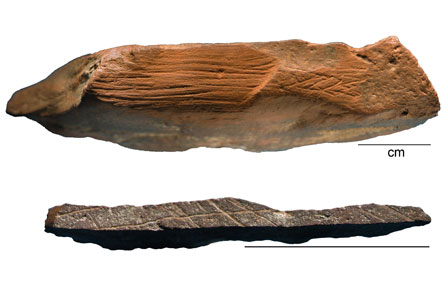Engraved pigments point to ancient symbolic tradition
Scientists excavating a Stone Age cave on South Africa’s southern coast have followed a trail of engraved pigments to what they suspect are the ancient roots of modern human behavior.
Analyses of 13 chunks of decorated red ochre (an iron oxide pigmen from Blombos Cave indicate that a cultural tradition of creating meaningful geometric designs stretched from around 100,000 to 75,000 years ago in southern Africa, say anthropologist Christopher Henshilwood of the University of the Witwatersrand in Johannesburg and his colleagues.
“What makes the Blombos engravings different is that some of them appear to represent a deliberate will to produce a complex abstract design,”Henshilwood says. “We have not before seen well-dated and unambiguous traces of this kind of behavior at 100,000 years ago.”
A microscopic analysis indicates that ochre designs were made by holding a piece of pigment with one hand while impressing lines into the pigment with the tip of a stone tool. On several pieces, patterns covered areas that had first been ground down.
Geometric patterns on the ochre pieces include cross-hatched designs, branching lines, parallel lines and right angles.Pigment powder had also been removed from many of the recovered ochre chunks. Incised patterns may have served as models for pigment designs applied to animal skins or other material, the scientists speculate.
Geometric patterns incised on pieces of ancient pigment, such as these 100,000-year-old finds, may reveal the surprisingly ancient origins of modern human behavior.
